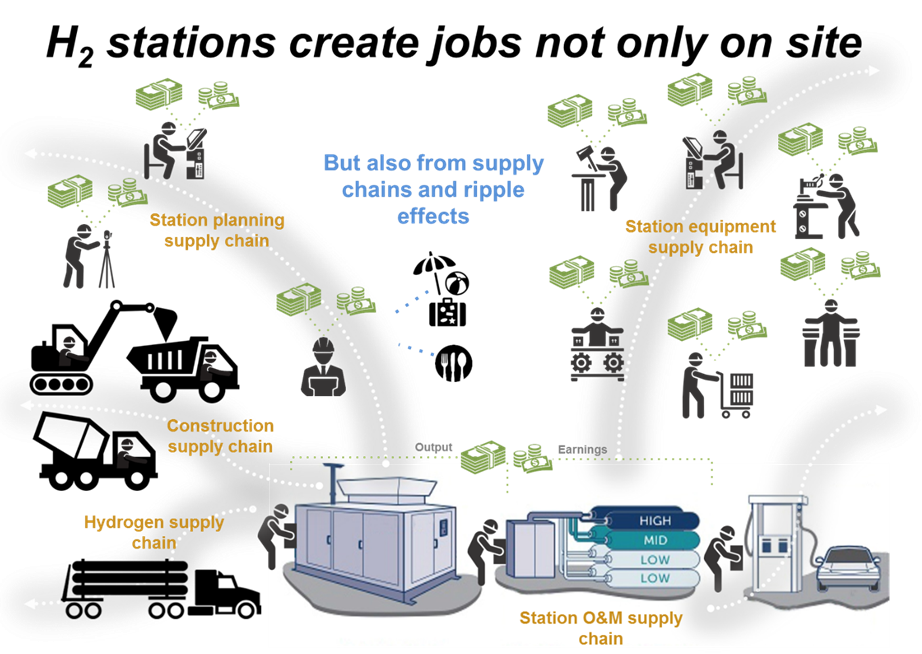http://phys.org/news/2014-09-tool-econo ... l-gas.html
Researchers at the U.S. Department of Energy's Argonne National Laboratory announced a new tool today for analyzing the economic impacts of building new compressed natural gas fueling stations. Called JOBS NG, ( http://jobsmodels.es.anl.gov/main?content=h2 ) the tool is freely available to the public.
Download Jobs NG Model: http://jobsmodels.es.anl.gov/files/jobsng-model
Download Jobs H2 Model: http://jobsmodels.es.anl.gov/files/jobsh2-model
Video Guide: http://jobsmodels.es.anl.gov/main?content=resources
JOBS H2 and JOBS NG use input-output methodology to estimate changes in industry expenditures, and then calculate the ripple effects of those changes throughout the economy for a user-selected geographic region of interest. As shown in the following illustration, multiple supply chains are required to develop and operate fueling stations. Equipment must be produced, procured from vendors, shipped and installed. The station itself must be designed, permitted, built and commissioned. And once the station is complete, equipment must be maintained, fuel must be produced and delivered, and other operating expenses must be paid. As these dollars flow through the economy they provide jobs and income to individuals and establishments directly involved in developing and operating stations (direct jobs), to individuals and establishments further up the supply chain (indirect jobs), and to an array of service and support industries whose growth is induced by the re-spending of those dollars in the economy (induced jobs).

While the above figure illustrates supply chains for hydrogen stations, natural gas station supply chains are similar. The most notable difference between them lies in how fuel is delivered to the station. For hydrogen stations fuel is supplied by truck in liquid or gaseous form. For CNG stations fuel is supplied via pipeline from local distribution companies.
Users can define a variety of scenarios with JOBS H2 and JOBS NG. They can specify various costs and operating parameters or use the defaults provided in the tool. To get started, users must decide whether they wish to look only at developing stations, only at operating stations, or at both station development and operation. Next, they must decide:
- What geographic region should be examined (i.e., the US as a whole, any one of the 50 states or any one of the nine census regions)?
- How many stations to begin developing in each year of the scenario?
- What size stations (in terms of kg/d capacity for hydrogen and either scfm or gge/day for natural gas) should be examined?
- For hydrogen stations, how long (one or two years) will station development take? And what will station utilization rate (kg H2 dispensed/kg capacity) be?
JOBS FC, JOBS H2 and JOBS NG are spreadsheet-based tools that use anticipated dollar flows within an economy to estimate economic impacts. As goods and services required to deploy fuel cells and hydrogen or natural gas infrastructure in a user-defined scenario are bought and sold, employment, earnings and economic output are produced which in turn generate additional employment, earnings and economic output.
As fuel-cell, hydrogen or natural gas infrastructure-related production proceeds down the supply chain (clockwise, from the extraction and supply of raw and finished materials, to the manufacture and assembly of components, to the distribution and integration of finished products), expenditures flow up the chain (counterclockwise) to the respective economic sectors. Fuel-cell and fuel infrastructure-related expenditures (hydrogen or natural gas) include the purchase of the fuel-cell and fueling infrastructure, energy/fuel and expenses associated with installing and operating the fuel cell and fueling infrastructure. As these dollars flow through the economy they provide jobs and income to individuals and establishments directly involved in the provision of fuel cells and fueling infrastructure (direct jobs), to individuals and establishments further up the supply chain (indirect jobs), and to an array of service and support industries whose growth is induced by the re-spending of those dollars in the economy (induced jobs).



